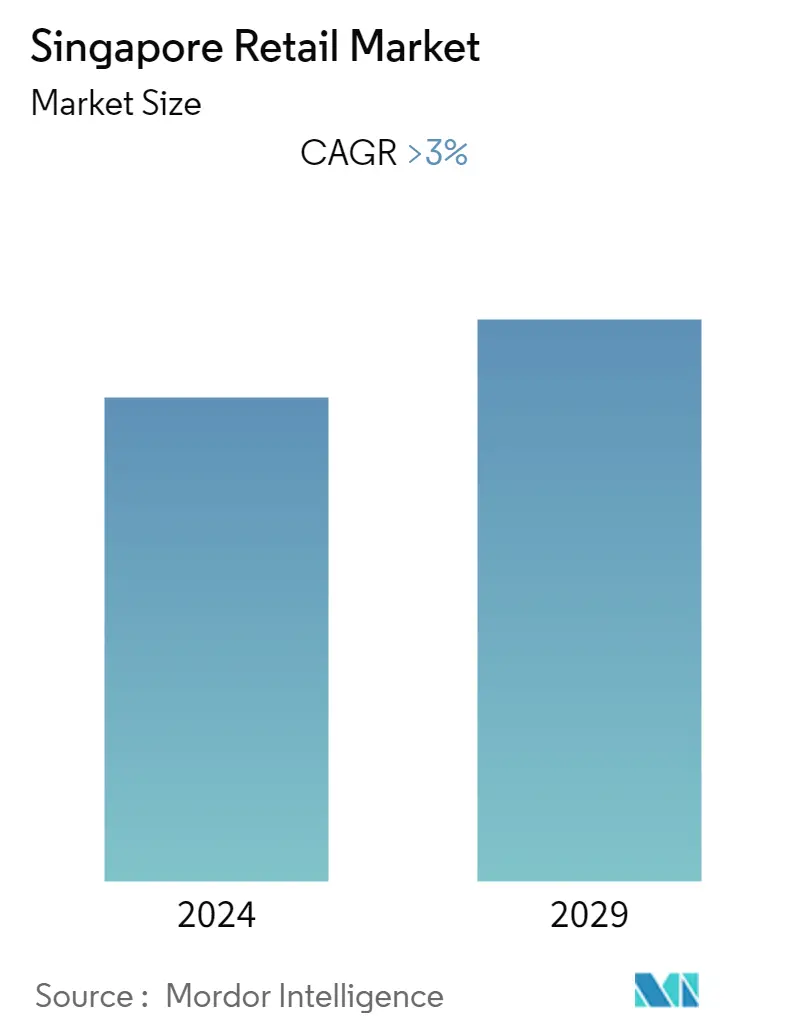Market Size of Singapore Retail Industry

| Study Period | 2019 - 2029 |
| Base Year For Estimation | 2023 |
| Forecast Data Period | 2024 - 2029 |
| Historical Data Period | 2019 - 2022 |
| CAGR | 3.00 % |
Major Players
*Disclaimer: Major Players sorted in no particular order |
Singapore Retail Market Analysis
The retail sector is one of the largest in Singapore, delivering constant growth during the study period. Though the global COVID-19 pandemic has restricted the market from registering growth during 2020 to a great extent, owing to the comparatively higher market of e-commerce retailing in the country, the market recorded a moderate growth rate in 2020. High-yielding market segments, including food and beverages, cosmetics, apparel and footwear, accessories, and furniture, recorded a sudden drop in revenues during the second quarter of 2020, which was the highest drop during the study period. Food retailers recorded a sales drop of 47.4% year on year, which is the largest segment in the market. Similarly, furniture and household appliances recorded a drop of around 19% for the second quarter in 2020.
As the retail landscape transformed with the COVID-19 outbreak, it has become increasingly important for retailers to adapt to multiple sales channels. The trend of more consumers going for e-commerce platforms to purchase several important goods and services has increased in the country, fuelled by the closure of many physical retailing spaces and brick-and-mortar stores due to the safety measures. With the rising number of businesses planning to switch to the e-commerce channel, the Singaporean government introduced the Digital Resilience Bonus under the SMEs Go Digital program to encourage more businesses to digitalize. This includes a payout of up to SGD 5,000 for eligible businesses, should PayNow Corporate and e-invoicing and business process or e-commerce solutions be adopted.
Singapore Retail Industry Segmentation
The report on the Singapore retail sector provides a comprehensive evaluation of the market, with an analysis of the segments in the market. The Singapore Retail Sector is segmented by Products into Food and Beverages, Personal and Household Care, Apparel, Footwear and Accessories, Furniture, Toys and Hobby, Electronic and Household Appliances, and Other Products. By Distribution Channel, the market is segmented into Hypermarkets, Supermarkets and Convenience Stores, Specialty Stores, Department Stores, E-commerce, and Other Distribution Channels. The report offers market size and forecasts for the Singapore retail sector in Value (USD million) for all the above segments.
Singapore Retail Market Size Summary
The retail industry in Singapore is a significant contributor to the country's economy, demonstrating resilience and adaptability despite challenges such as the COVID-19 pandemic. The pandemic initially caused a downturn in various retail segments, particularly in food and beverages, cosmetics, apparel, footwear, accessories, and furniture, with substantial revenue declines noted in the second quarter of 2020. However, the shift towards e-commerce became more pronounced as consumers increasingly turned to online platforms for their shopping needs, driven by the closure of physical stores. The Singaporean government supported this digital transformation through initiatives like the Digital Resilience Bonus, encouraging businesses to adopt e-commerce solutions and other digital tools to enhance their operations.
As the retail landscape evolves, technological advancements such as Augmented Reality (AR) and Virtual Reality (VR) are being integrated to attract and engage millennial consumers, who represent a significant portion of retail spending. Despite economic slowdowns affecting consumer spending patterns, certain segments like electronics and apparel have shown resilience, while others like furniture and household goods have seen reduced demand. The organized retail market is expanding, with major players dominating the sector and replacing unorganized outlets with larger retail formats. This trend is expected to continue, driving further growth in the Singaporean retail market over the forecast period.
Singapore Retail Market Size - Table of Contents
-
1. MARKET INSIGHTS AND DYNAMICS
-
1.1 Market Overview
-
1.2 Market Drivers
-
1.3 Market Restraints/Challenges
-
1.4 Value Chain / Supply Chain Analysis
-
1.5 Porter's Five Forces Analysis
-
1.6 Consumer Behavior Analysis
-
1.7 Insights on Technological Innovations in the Retail Industry
-
1.8 Impact of COVID-19 on the Market
-
-
2. MARKET SEGMENTATION
-
2.1 By Product
-
2.1.1 Food and Beverage
-
2.1.2 Personal and Household Care
-
2.1.3 Apparel, Footwear, and Accessories
-
2.1.4 Furniture, Toys, and Hobby
-
2.1.5 Electronic and Household Appliances
-
2.1.6 Other Products
-
-
2.2 By Distribution Channel
-
2.2.1 Hypermarkets, Supermarkets, and Convenience Stores
-
2.2.2 Specialty Stores
-
2.2.3 Department Stores
-
2.2.4 E-commerce
-
2.2.5 Other Distribution Channels
-
-
Singapore Retail Market Size FAQs
What is the current Singapore Retail Market size?
The Singapore Retail Market is projected to register a CAGR of greater than 3% during the forecast period (2024-2029)
Who are the key players in Singapore Retail Market?
Japan Foods Holding Ltd, Sheng Siong Group Ltd, Watsons, ABR Holdings Ltd and Dairy Farm International Holdings (DFI) are the major companies operating in the Singapore Retail Market.

